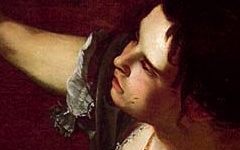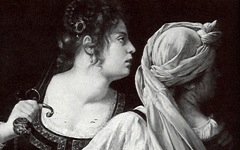Artemisia Gentileschi’s Judith and Her Maidservant Slaying Holofernes
This picture by Artemisia Gentilleschi of Judith slicing off Holofernes' head is thought to have been painted shortly after she was raped by the painter she was studying under.1 Interpreters have thus seen this grisly scene as some sort of reprisal. That might be so but it would not be poetry.

Artemisia Gentileschi, Judith and Her Maidservant Slaying Holofernes (1612-13) oil on canvas. Museo di Capodimonte, Naples.
Click image to enlarge.
The poetry in this painting can be found by recognizing that Judith (who may be a self-portrait) represents the artist “painting” the head of Holofernes with her sword as a paintbrush. The blood is “paint”.2 Holofernes’ severed head represents her actual painting because a masterpiece in Italian is un capolavoro, literally head-work. Though never recognized before, it is a pun of great significance to many Italian artists over the centuries.3
Click next thumbnail to continue
Lastly, the outstretched and horizontal arms of Judith, and the similarly patterned forearms of Holofernes, resemble each other, thus suggesting that the painter paints herself even if her gender changes. Indeed, in “painting” a man and a general, Artemisia refers to the androgyny and power of her own creative mind.4
More Works by Gentileschi
Here is a good example of how borrowed form borrows meaning. In Artemisia's self-portrait as an Allegory of Painting, she thought of herself as a personification of Art...

Artemisia Gentileschi’s Allegory of Painting (c.1630)
Notes:
1. Garrard, 1989, p.32
2. In another painting by Artemisia of Jael and Sisera Mann recently saw “a parallel between Jael’s act of violence and .. [Artemisia’s] own painted recreation of that violence…” Judith Mann, “Identity signs: meanings and methods in Artemisia Gentileschi’s signatures”, Renaissance Studies 23, Feb. 2009, p. 94
3. Although the first known literary use of the Italian word for "masterpiece", capolavoro, dates from around 1700, the concept is likely to have been used in speech sometime earlier. Yet, even without the current meaning of capolavoro, artists who thought of their art as a description of their own mind could have used an executed head as a metaphor for it. In other words, given that every painter paints himself and thus that both executioner and victim represent the artist, the victim's executed head becomes a metaphor for the artist's own work, his head-work or thoughts.
For the first known use of capolavoro, see Grande Dizionario della Lingua Italiana, v. II, ed. Salvatore Battaglia (Turin: Unione Tipografico) 1961, p.708
4. There is a possibility that their parallel arms refer to Caravaggio’s Narcissus who looks down between his more outspread arms onto the surface of the reflecting pool. It was a form that Artemisia used with greater resemblance in her Allegory of Painting.
Original Publication Date on EPPH: 20 Apr 2010. | Updated: 0. © Simon Abrahams. Articles on this site are the copyright of Simon Abrahams. To use copyrighted material in print or other media for purposes beyond 'fair use', you must obtain permission from the copyright owner. Websites may link to this page without permission (please do) but may not reproduce the material on their own site without crediting Simon Abrahams and EPPH.


